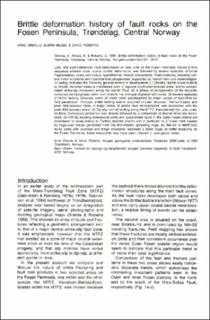Brittle deformation history of fault rocks on the Fosen Peninsula, Trøndelag, Central Norway.
Journal article
Permanent lenke
https://hdl.handle.net/11250/2674265Utgivelsesdato
1991Metadata
Vis full innførselSamlinger
- Artikler [1064]
Sammendrag
Late and post-Caledonian fault deformation of rock units on the Fosen Peninsula follows a time sequence wherein lower crustal ductile deformation was followed by several episodes of brittle fragmentation, some with coeval hydrothermal mineral precipitation. Field evidence, including various minor structures and hydrothermal parageneses, supported by fission-track and palaeomagnetic dating, indicates the following general history of development: (1) Sinistral ductile shear in Early to Middle Devonian times is manifested both in regional south-west-directed shear and in concentrated strike-slip movement along the Verran fault. (2) A phase of retrogression of the mylonitic rocks can be recognised within and close to the principal displacement zones. (3) Several episodes of brittle faulting followed, some of which were accompanied by major pulses of hydrothermal fluid penetration. Principal brittle faulting events occured in Late Devonian, Permo-Triassic and post-Mid-Jurassic times. A major phase of zeolite fault mineralisation was associated with the post-Mid-Jurassic event. (4) Dip-slip normal faulting along the MTFZ characterised the Late Jurassic\/Early Cretaceous period but was directly followed by a component of dextral strike-slip movement. (5) NW-SE trending extensional joints and subordinate faults in the Outer Fosen district are consedered to relate mainly to Tertiary tectonic events and in particular to a stress field created by ridge-push forces generated from the Mid-Atlantic spreading ridge. (6) NW-Se to NNW-SSE minor joints with plumose and fringe structures represent a latest stage of brittle fracturing on the Fosen Peninsula; these mesojoints may have been initiated in post-glacial times.

